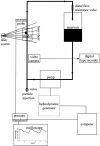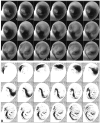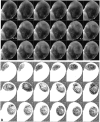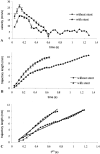Anatomically shaped internal carotid artery aneurysm in vitro model for flow analysis to evaluate stent effect
- PMID: 15569741
- PMCID: PMC8148744
Anatomically shaped internal carotid artery aneurysm in vitro model for flow analysis to evaluate stent effect
Abstract
Background and purpose: Stent implantation alone might not be sufficient to produce definitive treatment of cerebral aneurysms. Therefore, extended experimental work is needed to improve results. We show the feasibility of using an in vitro anatomically shaped elastic model for flow evaluation before and after stent implantation.
Methods: Based on human vascular casting, an anatomic elastic internal carotid artery model, including an aneurysm on the supraclinoid portion, was manufactured. The model was connected to a circulatory loop to simulate physiological flow. After visualization of the flow by using glass particles and laser sheet translumination, the digitally recorded data were transferred for computer analysis. Intra-saccular flow pattern changes and the vortex velocity reduction induced by the stent were investigated qualitatively and quantitatively.
Results: The distal neck of the aneurysm behaved as a flow divider. Therefore, it was directly exposed to the hemodynamic stress. Inside the sac, a well-defined vortex formed and progressed along the wall toward the proximal neck. After stent implantation this pattern changed significantly; the vortex appeared more dispersed and its residence time increased. The velocity reduction was 32%. Velocity peak was observed close to the distal neck in both cases.
Conclusion: In vitro anatomic elastic models are feasible for flow evaluation with laser sheet translumination. In our model, stent implantation resulted in hemodynamic changes that might favor the exclusion of the aneurysm from the circulation and can prevent regrowth of the aneurysmal sac.
Figures








References
-
- Molyneux A, Kerr R, Stratton I, et al. International Subarachnoid Aneurysm Trial (ISAT) of neurosurgical clipping versus endovascular coiling in 2143 patients with ruptured intracranial aneurysms: a randomised trial. Lancet 2002;26:1267–1274 - PubMed
-
- Guglielmi G, Viñuela F, Duckwiler G, et al. Endovascular treatment of posterior circulation aneurysms by electrothrombosis using electrically detachable coils. J Neurosurg 1992;77:515–524 - PubMed
-
- Lin T, Fox AJ, Drake CG. Regrowth of aneurysm sacs from residual neck following aneurysm clipping. J Neurosurg 1989;70:556–560 - PubMed
-
- Drake CG, Allcock JM. Postoperative angiography and the “slipped” clip. J Neurosurg 1973;39:683–689 - PubMed
-
- Ng P, Khangure MS, Phatouros CC, Bynevelt M, ApSimon H, McAuliffe W. Endovascular treatment of intracranial aneurysms with Guglielmi detachable coils: analysis of midterm angiographic and clinical outcomes. Stroke 2002;33:210–217 - PubMed
Publication types
MeSH terms
LinkOut - more resources
Full Text Sources
Medical
